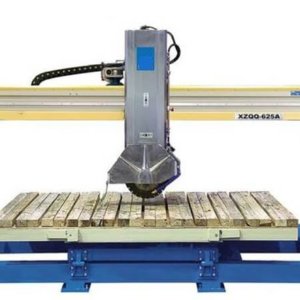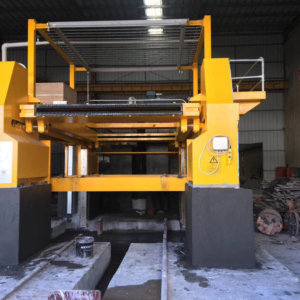As a professional manufacturer of stone equipment, we are excited to share with you everything you need to know about quartz polishing machine. These machines are essential for achieving smooth, polished surfaces on quartz countertops, tiles, and other products. In this post, I will cover:
1. Definition of quartz polishing machine
2. Features of quartz polishing machine
3. Specifications of quartz polishing machine
4. Applications of a quartz polishing machine
5. Maintenance and operation of a quartz polishing machine
6. More Details of Quartz Polishing Machine
7. Polishing Pads on Quartz Polishing Machine
8. Common issues on Quartz Polishing Machine

Definition of a Quartz Polishing Machine
A quartz polishing machine is an industrial-grade equipment designed specifically for grinding, polishing, and buffing quartz surfaces to achieve a smooth, shiny, and attractive finish. These machines use a combination of abrasive materials, polishing pads, and water to minimize heat and friction, ensuring a high-quality finish without damaging the quartz material.


Specifications of Quartz Polishing Machine
| Type | Unit | HN-12C | HN-16C | HN-18C | HN-20C |
|---|---|---|---|---|---|
| Quantity of polishing head | pcs | 12 | 16 | 18 | 20 |
| Useful working width | mm | 600-2100 | 600-2100 | 600-2100 | 600-2100 |
| Useful working thickness | mm | 15-50 | 15-50 | 15-50 | 15-50 |
| Transfer speed | mm/min | 0-3500 | 0-3500 | 0-3500 | 0-3500 |
| Water consumption | m³/h | 22 | 25 | 26 | 28 |
| Motor power of grinding head | kw | 15 | 15 | 15 | 15 |
| Total power | kw | 137 | 181 | 203 | 225 |
| Overall dimension(L*W*H) | mm | 9600*3200*2300 | 11600*3200*2300 | 12600*3200*2300 | 13600*3200*2300 |
| Gross weight | T | 24 | 27 | 28 | 29 |
Features of a Quartz Polishing Machine
– Variable Speed Control:
Quartz polishing machines offer adjustable speed settings, allowing operators to control the polishing process and achieve the desired finish.
– Automatic Polishing System:
Many quartz polishing machines have an automatic polishing system that ensures consistent pressure and movement for a uniform finish.
– Water Cooling System:
To prevent overheating and damage to the quartz surface, these machines often use a water cooling system that helps dissipate heat generated during the polishing process.
– Durable Construction:
Quartz polishing machines are built with heavy-duty materials, such as stainless steel and aluminum, ensuring long-lasting performance and minimal wear and tear.
– Easy-to-Change Polishing Pads:
To maintain the machine’s efficiency, it’s crucial to replace worn-out polishing pads. Quartz polishing machines typically feature a quick-release system for changing pads with ease.



Applications of a Quartz Polishing Machine
Quartz polishing machines are used across various industries for a range of applications, including:
– Quartz Countertops:
These machines are instrumental for polishing quartz countertops in kitchens and bathrooms, ensuring a smooth, high-quality surface.
– Quartz Tiles:
Quartz tiles used for flooring, walls, and other applications require a polished finish, which is achieved using quartz polishing machines.
– Monuments and Sculptures:
Quartz monuments and sculptures require a precise polish to highlight their intricate details and enhance their overall appearance.
– Quartz Slabs:
Quartz slabs used for various construction and design applications must be polished to achieve the desired finish.


Maintenance and Operation of Quartz Polishing Machine
To ensure the longevity and optimal performance of your quartz polishing machine, follow these maintenance and operation tips:
– Regular Inspection:
Regularly inspect the machine for any signs of wear, damage, or loose components. Address issues promptly to prevent more significant problems.
– Lubrication:
Keep all moving parts well-lubricated to minimize friction and wear.
– Polishing Pad Replacement:
Replace worn-out polishing pads as needed to maintain the machine’s efficiency and prevent damage to the quartz surface.
– Proper Training:
Ensure that all operators are well-trained in the safe and correct use of the quartz polishing machine.
– Follow Manufacturer Guidelines:
Adhere to the manufacturer’s guidelines for maintenance, cleaning, and operation to prolong the machine’s lifespan and ensure optimal performance.

More Tips of Quartz Polishing Machine
– Types of Quartz Polishing Machines:
There are two main types of quartz polishing machines – automatic and manual. Automatic machines are typically used for larger projects and have computer-controlled settings for precise polishing. Manual machines are better suited for smaller jobs where more control is needed over the polishing process.
– Diamond Powder:
As previously mentioned, diamond powder is a common abrasive material used in quartz polishing machines. It comes in different mesh sizes, with coarser powder used for grinding and finer powder used for polishing. The diamond powder is applied to the surface of the stone using a polishing pad or wheel.
– Wet vs. Dry Polishing:
Quartz polishing machines can be used for both wet and dry polishing. Wet polishing uses water to cool the machine and prevent dust from getting airborne, while dry polishing relies on suction systems to collect dust. Wet polishing is generally preferred as it results in a smoother finish and reduces the risk of cracking or overheating the stone.
– Maintenance Tips:
In addition to regular cleaning and oiling, it’s important to regularly check the machine’s belts and bearings for wear and tear. If these parts become damaged, they can cause the machine to malfunction or stop working altogether. It’s also important to replace the polishing pads or wheels when needed, as worn-out pads can create uneven finishes on the stone.

Polishing Pads on Quartz Polishing Machine
The frequency at which you should replace the polishing pads on your quartz polishing machine depends on various factors such as the type of pad, the intensity and duration of use, and the specific requirements of the quartz surface you are working on.
As a general rule of thumb, it’s recommended to replace your polishing pads after every 10-15 uses or when you notice that they are no longer producing the desired results. However, this can vary based on the quality of the pads, the amount of pressure applied during use, and the frequency of use.
To extend the life of your polishing pads, it’s essential to clean them regularly and store them in a dry and protected environment when not in use. This will help prevent damage and ensure that they maintain their effectiveness for as long as possible.

Common Issues on Quartz Polishing Machine
There are several common issues that can arise when using a quartz polishing machine, including:
1. Uneven or inconsistent polishing:
This can occur if the polishing pads are worn or damaged, or if they are not being used correctly.
2. Scratching or damaging the surface:
This can happen if the wrong type of pad is used, or if the machine is operated at too high of a speed or with too much pressure.
3. Overheating:
Running the machine for extended periods without breaks can cause it to overheat, which can lead to damage to the machine and the polishing pads.
4. Dust accumulation:
The polishing process can create a lot of dust, which can accumulate on the machine and in the work area. This can affect the performance of the machine and impact the quality of the final product.
5. Water damage:
Using too much water during the polishing process can damage the machine’s electrical components and lead to electrical shock.
To avoid these issues, it’s important to follow the manufacturer’s instructions for operating the machine and using the correct pads for the specific type of quartz you are working with. Regular maintenance, such as cleaning and replacing worn or damaged parts, can also help prevent issues from arising.
In conclusion, a quartz polishing machine is an essential tool for achieving a smooth and polished finish on quartz surfaces. With various features, applications, and proper maintenance, these machines can provide a long-lasting and efficient solution for all your quartz polishing needs.
















